

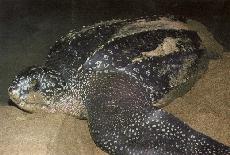 The Class of Reptiles, where the marine turtles belonging to, developed from
Amphibians about 300 million years ago during the Carboniferous period. Turtles, and
particularly marine turtles appeared more recently.
Data agree in regarding them as fairly common during the Cretaceous period (150 million years
ago), even though there are some fossil remains, which date back to more than 200 million years
ago. All the species living at the present time go back to the Cenozoic era, more precisely to the
period that go from the Eocene to the Pleistocene epochs, approximately from 60 to 10 million
years ago.
The Class of Reptiles, where the marine turtles belonging to, developed from
Amphibians about 300 million years ago during the Carboniferous period. Turtles, and
particularly marine turtles appeared more recently.
Data agree in regarding them as fairly common during the Cretaceous period (150 million years
ago), even though there are some fossil remains, which date back to more than 200 million years
ago. All the species living at the present time go back to the Cenozoic era, more precisely to the
period that go from the Eocene to the Pleistocene epochs, approximately from 60 to 10 million
years ago.
Having existed on Earth for all that time, marine turtles are today threatened with extinction. Habitant degradation due to uncontrolled costal development, tourism, noise and lights disturbance, increasing of incidental catches through fisheries interaction and sea-pollution, in one word - human activities, is the main reason for alarming decline of world populations.
When Christopher Colombo have seen San Salvador ground from the Santa Maria deck for the first time in 1492, he was amazed by numerous "small reefs" in the water. It turned out that the reefs were thousands of marine turtles basking on the sun. Even in 1947 on the Ranch Nuevo beach in Tamaulipas, Mexico the nesting-female population of about 40,000 Kemp's Ridley was recorded in a single day. The arribada - "arrival" - of thousands of Pacific Ridley females in one day on Ostional Beach, Costa Rica, was one of nature's most spectacular phenomena.
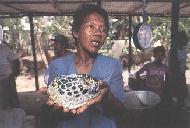 Such large quantity of helpless "meet" on the nesting-beaches in short period gives a new
idea to humans: we have started a new industry based on the marine turtles. The meat (especially
from the green turtle) become prized delicacy; flippers could be used for leather products,
cartilage for turtle soup, and shell for jewelry. Laid eggs were collected as an aphrodisiac, and
the hatchlings were ideal for making the souvenirs. So the slaughter start.
From 40,000 of Kemp's Ridley nesting on Ranch Nuevo in 1947, this days remains only about
500 specimens.
Such large quantity of helpless "meet" on the nesting-beaches in short period gives a new
idea to humans: we have started a new industry based on the marine turtles. The meat (especially
from the green turtle) become prized delicacy; flippers could be used for leather products,
cartilage for turtle soup, and shell for jewelry. Laid eggs were collected as an aphrodisiac, and
the hatchlings were ideal for making the souvenirs. So the slaughter start.
From 40,000 of Kemp's Ridley nesting on Ranch Nuevo in 1947, this days remains only about
500 specimens.
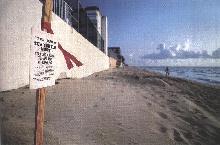 Furthermore, with intensive tourism development man become rival with marine turtles
for a sandy beaches. In a race with humans turtles come out as a losers. Noise and the lights on
beaches, vehicles, sun umbrellas, deck-chairs, propeller-powered speedboats together with out-of-control tourism disturb, disorientate, frighten, injure and prevent turtles from nesting.
Furthermore, with intensive tourism development man become rival with marine turtles
for a sandy beaches. In a race with humans turtles come out as a losers. Noise and the lights on
beaches, vehicles, sun umbrellas, deck-chairs, propeller-powered speedboats together with out-of-control tourism disturb, disorientate, frighten, injure and prevent turtles from nesting.
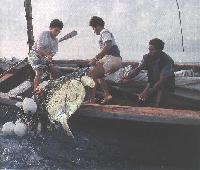
With improvement of fishing techniques more and more turtles die in the fishing nets every year. In USA in 1981 more than 12,600 turtles died as a result of shrimping operations. The same problems is in the Mediterranean with swordfish long liners. Between 22,000 and 24,000 of marine turtles are incidentally caught every year only in south Balearic aquatorium. The turtles are usually unable to surface for air, so they drown dead.
Pollution of world oceans by plastic, broken nets, ropes and all other kind of dumped 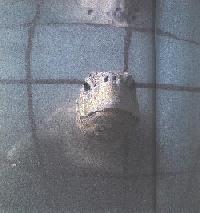 waste also interferes marine turtles life. Plastic bags in the sea are often being mistaken for
turtles favorite jellyfish. Swallowed plastic bag is blocking their digestive system, and causing
the death of the animal. Also, all kinds of toxic effluents circulating in the seas today suppress
immunological system of turtles, causing all kinds of diseases.
waste also interferes marine turtles life. Plastic bags in the sea are often being mistaken for
turtles favorite jellyfish. Swallowed plastic bag is blocking their digestive system, and causing
the death of the animal. Also, all kinds of toxic effluents circulating in the seas today suppress
immunological system of turtles, causing all kinds of diseases.
Because of all human activities, marine turtles become today one of the most threatened animals in the world. Despite all researches and paper-protection over the last years, their situation continues to decline. Today, few beaches in Greece, Turkey and Cyprus retain the largest nesting areas in the Mediterranean.
The only way to help our Mediterranean marine turtle in their fight for future is a organized global conservation strategy, on which is the Adriatic Marine Turtle Program as a part of Global Mediterranean Program based.
